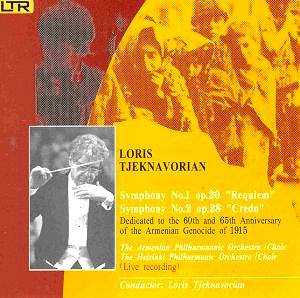Tjeknavorian is Iranian
by birth. At one time, in the 1970s
into the 1980s, his exclusive contract
with RCA (now BMG) produced a prodigious
crop of LPs many of which have never
been reissued on CD. ASV-Sanctuary rekindled
his international recording career with
a large number of Soviet composer recordings
- many central Asian. As a composer
his presence was announced internationally
by several LPs on Unicorn - the label
for connoisseurs of the leading edge.
These included the ballet Simorgh
and the First Symphony (for percussion
ensemble, celesta and John Wallace's
trumpet). Lama coupled his first two
symphonies on their LP LAM001. This
included a new lease of life for the
Unicorn version of the First Symphony.
The present disc is
on Tjeknavorian's own label and gives
us the two works in their authentic
versions with choir.
The symphonies respectively
mark the 60th and 65th anniversaries
of the apocalyptic slaughter of the
Armenians in 1915. The First Symphony's
massively weighty clashing dissonance
and wailing massed choirs resounds and
thrashes with awesome Old Testament
barbarism. Mixed in we also hear a style
related to the furies unleashed by Penderecki
during the avant-garde 1960s. Textures
lighten for the stamping Requiem
third movement whose high-pitched writing
for woodwind and brass recalls Shostakovich.
A Middle Eastern sinuous wail appears
for the first time at 1.30 in tr. 4.
The exhaustion of emotion and physical
strength can be felt in the fifth movement
finale Lament-Protest. Here the
music rediscovers the gentle emotions
of healing and tenderness. This is one
of those works that, despite its brevity,
radiates a Brucknerian timelessness
and eternity. Uncomfortable listening
but salutary and ending with a great
savage scream of victory.
After too short a pause
we move into the Credo Symphony
which explores the same subject. Its
four movements are played without pause
although tracked individually. Like
its predecessor Symphony the first movement
is entitled Menace. The whispered
quiet writing has some parallels with
Panufnik and with Stravinsky's Rite.
There is some truly magical writing
here including some in which a mildly
glowing canvas of sound is created (from
4.12). The seething fury-suppressed
textures of the Polish 1960s are again
in angry evidence. The Massacre
movement is a little more transparent
than its counterpart in the First Symphony.
The music seems to hold the door open
to some seething Gehenna but the infernal
scene quickly fades to be replaced by
a steely quiet tension. The Credo
finale arises like a benediction
- stronger and with more healing than
anything proffered by the First Symphony.
Through a ceaseless celebratory jangle
of bells, hammers and other 'metallica'
a noble Credo is sung by the
choir. About it there is something of
the Orthodox church's Easter benediction
as well as the seductive diaphanous
aural clouds released by Szymanowski
in King Roger. The sense of blessing
and sustained joy in processional also
reminded me of Paray's St Joan Mass.
If you have the Lama
LP you will know the version of the
First Symphony for the London Percussion
Virtuosi with solo celesta and trumpet.
That stripped down instrumentation does
allow greater transparency while at
the same time accenting an unleashed
fury similar to the central panel of
Panufnik's Sinfonia Elegiaca.
This is very raw music. The Second Symphony
is performed on the Lama vinyl by the
Helsinki Philharmonic but without choir.
This recording sounds like a studio
inscription possibly made during Tjeknavorian's
visit to Helsinki for the concert premiere.
The experience of meeting
these two works is like hearing first
and second thoughts on related material.
The symphonies meet unthinkable tragedy
on its own terms; there is no shying
away; no evasion. They make uncomfortable
listening but in the Second Symphony
the Credo brings balm without
washing away the memory.
Rob Barnett
